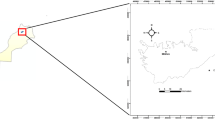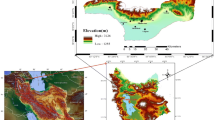Abstract
Miandoab plain aquifer, with 1150-km2 area, supplies a significant portion of the agricultural and drinking water demands of the area. In recent years, it has been faced with a significant decline in water level as a consequence of the deterioration of groundwater quality. Therefore, a scientific study of the groundwater resources in the study area for quantitative and qualitative management is necessary. One of the important indicators for assessing and zoning of the groundwater quality is the measurement of the concentrations of the ions and determining the groundwater quality index (GQI) by combining ion concentrations and their relationship with reliable standards. For this purpose, in October 2018, 75 water samples from the groundwater resources of the Miandoab plain aquifer were collected and chemically analyzed. To minimize the uncertainties, the fuzzy groundwater quality index was used by the fuzzification of the GQI method. Also, the random forest (RF) algorithms, as a learning method based on an ensemble of decision trees, were used for the assessment of groundwater quality. The RF technique has advantages over the other methods due to having high prediction accuracy, the ability to learn nonlinear relationships, and the ability to determine the important variables in the prediction. In the validation and comparison of methods, fuzzy groundwater quality index method with more accuracy is identified as a more reliable method in groundwater quality evaluation for drinking purposes. Based on the RFGQI results, 20, 16, 15, 26, and 23% of the Miandoab plain aquifer, respectively, has a suitable, acceptable, moderate, unsuitable, and absolutely unsuitable groundwater quality. Overall, the results of this study showed that the random forest method can be used as a reliable method for groundwater vulnerability, investigating and properly managing or monitoring of the aquifers.









Similar content being viewed by others
References
Adimalla N, Li PY (2019) Occurrence, health risks, and geochemical mechanisms of fluoride and nitrate in groundwater of the rock-dominant semi-arid region, Telangana State, India. Hum J Ecol Risk Assess 25:81–103
Adimalla N, Qian H (2019) Groundwater quality evaluation using water quality index (WQI) for drinking purposes and human health risk (HHR) assessment in an agricultural region of Nanganur, South India. J Ecotoxicol Environ Saf 176:153–161
Al-hadithi M (2012) Application of water quality index to assess suitability of groundwater quality for drinking purposes in Ratmao-Pathri Rao watershed, Haridwar District India. J Sci Ind Res 23:1321–1336
Amalraj A, Pius A (2018) Assessment of groundwater quality for drinking and agricultural purposes of a few selected areas in Tamil Nadu South India: a GIS-based study. J Sustain Water Recourse Manag 4(1):1–21
Babiker IS, Mohamed MAA, Hiyama T (2007) Assessing groundwater quality using GIS. J Water Resour Manag 21:699–715
Barua, A., Mudunuri, L.S., Kosheleva, O. 2014. Why trapezoidal and triangular membership functions work so well: towards a theoretical explanation. Departmental Technical Reports (CS). Paper 783
Bellman R (2003) Dynamic programming. Dover Publications, Mineola, 366 pp
Blum AL, Langley P (1997) Selection of relevant features and examples in machine learning. J Artif Intell 97(1–2):245–271
Booker DJ, Snelder TH (2012) Comparing methods for estimating flow duration curves at ungauged sites. J Hydrol 434–435:78–94
Breiman L (2001) Random forests. Mach Learn 45(1):5–32
Chapman D (ed) (1996) Water quality assessments - a guide to use of biota, sediments and water in environmental monitoring, 2nd edn. E&FN Spon, London
EARWO (East Azerbaijan Regional Water Organization). 2014. Preparation of water balance and water cycle in the Malekan region. 56p
Emberger L (1952) Sur le quotient pluviothermique. C R Sci 234:2508–2511
Friedl MA, Brodley CE, Strahler AH (1999) Maximizing land cover classification accuracies produced by decision trees at continental to global scales. IEEE Trans Geosci Remote Sens 37(2):969–977
Gareth J, Daniela W, Trevor H, Robert T (2013) An introduction to statistical learning. Springer. 32:316–321
Guyon I, Elisseeff A (2003) An introduction to variable and feature selection. J Mach Learn Res 3:1157–1182
Herrera M, Torgo L, Izquierdo J, Pérez-García R (2010) Predictive models for forecasting hourly urban water demand. J Hydrol 387(1–2):141–150
Hiyama TL, Hu CY (2003) Application of two stage fuzzy set theory to river quality evaluation Taiwan water resources. J Water Resour Manag 37:1406–1410
Huang J, Xu J, Liu X, Liu J, Wang L (2011) Spatial distribution pattern analysis of groundwater nitrate nitrogen pollution in Shandong intensive farming regions of China using neural network method. J Math Comput Model 54(3–4):995–1004
Jamshidzadeh Z, Barzi M (2018) Groundwater quality assessment using the portability water quality index (PWQI): a case in the Kashan plain, Central Iran. J Environ Earth Sci 77(3):59
Klir G, Yuan B (1995) Fuzzy sets and fuzzy logic, 4th edn. Prentice Hall, Upper Saddle River
Kotsiantis S, Pintelas P (2004) Combining bagging and boosting. Int J Comput Intell 1(4):324–333
Kumar S, Sangeetha B (2020) Assessment of groundwater quality in Madurai city by using parameter geospatial techniques. J Groundw Sustain Dev 10:657–668
Liu X, Xu MM, Huang J, Shi C, Yu XF (2003) Application of geostatistic and technique to characterize spatial variabilities of bioavailable micronutrients in paddy soils. J Agron Environ 12(2):88–91
Nadiri AA, Norouzi H, Khatibi R, Gharekhani M (2019) Groundwater DRASTIC vulnerability mapping by unsupervised and supervised techniques using a modelling strategy in two levels. J Hydrol 574:744–759
Nejatijahromi Z, Nassery HR, Hosono T, Nakhaei M, Alijani F, Okumura A (2019) Groundwater nitrate contamination in an area using urban wastewaters for agricultural irrigation under arid climate condition, southeast of Tehran, Iran. J Agric Water Manag 221:397–414
Norouzi H, Shahmohammadi-Kalalagh S (2019) Locating groundwater artificial recharge sites using random forest: a case study of Shabestar region, Iran. J Environ Earth Sci 78:380
Norouzi H, Moghaddam AA, Nadiri AA (2016) Determining vulnerable areas of Malekan plain aquifer for nitrate, using random forest method. J Environ Stud 41(4):923–942
Norouzi H, Nadiri AA, Moghaddam AA (2018a) Identifying the susceptible area of Malikan plain aquifer to contamination using fuzzy methods. Journal of environmental studies 44(2):205–221
Norouzi H, Nadiri AA, Moghaddam AA, Gharekhani M (2018b) Comparing performance of fuzzy logic, artificial neural network and random forest models in transmissivity estimation of Malekan plain aquifer. J Ecohydrol 5(3):739–751
Pal M (2005) Random forest classifier for remote sensing classification. Int J Remote Sens 26(1):217–222
Peters J, Baets BD, Verhoest NEC, Samson R, Degroeve S, Becker PD (2007) Random forests as a tool for ecohydrological distribution modelling. Ecol Model 207(2–4):304–318
Quinlan JR (1986) Induction of decision trees. J Mach Learn 1(1):81–106
Rodriguez V, Ghimire B, Rogan J, Chica-Olmo M, Rigol-Sánchez JP (2012) An assessment of the effectiveness of a random forest classifier for land-cover classification. ISPRS J Photogram Remote Sens 67(9):104
Saeys Y, Inza I, Larrañaga P (2007) A review of feature selection techniques in bioinformatics. Bioinformatics. 23(19):2507–2517
Sener S, Sener E, Davraz A (2017) Evaluation of water quality using water quality index (WQI) method and GIS in Aksu River (SW-Turkey). Journal of Science Total Environment 584:131–144
Sesnie S, Gessler P, Finegan B, Thessler S (2008) Integrating Landsat TM and SRTM-DEM derived variables with decision trees for habitat classification and change detection in complex geotropically environments. Journal of Remote Sensing of Environment 112(5):2145–2159
Shahrabi, M. 1972. Description of geological map of Urmia, Geological Survey of Iran. 81 p
Sihag P, Mohsenzadeh Karimi S, Angelaki A (2019) Random forest, M5P and regression analysis to estimate the field unsaturated hydraulic conductivity. J Appl Water Sci 9:129. https://doi.org/10.1007/s13201-019-1007-8
Vadiati M, Asghari-Moghaddam A, Nakhaei M, Adamowski J, Akbarzadeh A (2016) A fuzzy-logic based decision-making approach for identification of groundwater quality based on groundwater quality indices. J Environ Manag 184(2):255–270
WHO (World Health Organization) (2008) Guidelines for drinking-water quality, Second addendum, vol 1, Recommendations, 3rd edn., ISBN 9789241547604
Xu PP, Feng WW, Qian H, Zhang QY (2019) Hydrogeochemical characterization and irrigation quality assessment of shallow groundwater in the Central-Western Guanzhong Basin, China. Int J Environ Res Public Health 16:1492
Yajima H, Derot J (2018) Application of the random forest model for chlorophyll-a forecasts in fresh and brackish water bodies in Japan, using multivariate long-term databases. J Hydroinf 20(1):206–220
Yen J, Wang L (1999) Simplifying fuzzy rule-based models using orthogonal transformation methods. IEEE Trans Syst Man Cybern 29(1):13–24
Yung J, Abdulmohsin H, El-Shafie A, Koting S, Mohda N, Jaafar W, Hin L, AbdulMalek M, Ahmed A, Mohtar M, Elshorbagy A, El-Shafie A (2019) Towards a time and cost effective approach to water quality index class prediction. J Hydrol 575:148–165
Zadeh LA (1965) Fuzzy sets. Inf Control 8:338–353
Zhang YT, Wu JH, Xu B (2019) Human health risk assessment of groundwater nitrogen pollution in Jinghui canal irrigation area of the loess region, Northwest China. J Environ Earth Sci 77:12
Author information
Authors and Affiliations
Corresponding author
Additional information
Responsible Editor: Amjad Kallel
Rights and permissions
About this article
Cite this article
Norouzi, H., Moghaddam, A.A. Groundwater quality assessment using random forest method based on groundwater quality indices (case study: Miandoab plain aquifer, NW of Iran). Arab J Geosci 13, 912 (2020). https://doi.org/10.1007/s12517-020-05904-8
Received:
Accepted:
Published:
DOI: https://doi.org/10.1007/s12517-020-05904-8




